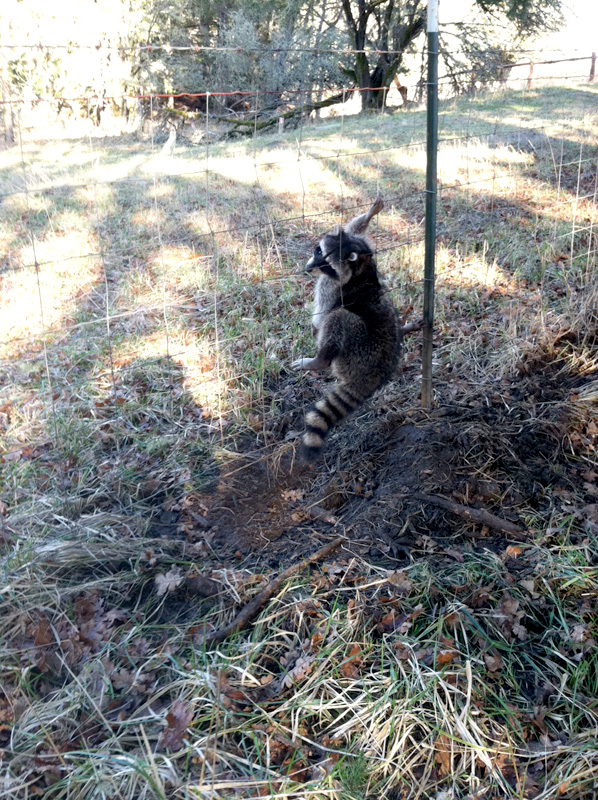Strangling snares being used again at OSU sheep farm

This raccoon and countless other
animals have been left to suffer
and die in snares at the OSU sheep
farm.
In 2012 our video, "End
Federal
Trapping
at OSU," brought
attention
to their
indiscriminate
trapping
practices. Now OSU is
back
at it and we are resuming
our efforts
to
stop them.
Watch video | Donate today
While home to cutting-edge research on the essential role predators play in ecosystems, OSU is yet again torturing and killing predators indiscriminately with lethal traps. We say it's long past time they gave proven nonlethal methods a real chance.
April 30, 2014 - A couple years ago we celebrated a partial victory at the Oregon State University (OSU) sheep farm. Under pressure from the public, OSU deactivated lethal traps they were using to "protect" their sheep from coyotes and other predators, traps that were torturing and killing wildlife and putting neighborhood pets and children at risk. Their actions were a relief to all, not to mention the innocent animals spared traumatic injury and/or death. Background
But this year's news isn't good. OSU is claiming their attempts at nonlethal control didn't work and they are again using lethal snares in a cooperative agreement with Wildlife Services, the incredibly misnamed and corrupt federal agency we are working so hard to reform. We are highly suspicious of the 2012 death statistics OSU provided and attributed to the use of nonlethal controls. The sheep deaths occured during two highly contagious disease outbreaks, and are therefore unlikely related to predation. We are researching this further.
Regardless of OSU's claims, the reality is they never even gave comprehensive nonlethal methods a chance. Our director, Brooks Fahy, offered his expertise to work with OSU sheep farm staff to implement nonlethal methods, but was never even acknowledged. And the farm shows no evidence of using comprehensive nonlethal methods. For example:
-
OSU did not secure or repair their exterior fence on property adjacent to residential homes to prevent access by wildlife, dogs or children.
- They never added a hot wire to the top and bottom of their fence. This is by far the cheapest, easiest and most-needed fix to deter predators.
- It appears the farm has yet to use a shepherd or guard dogs/llamas.
The irony is that, while they are back to using lethal snares, their sheep are still vulnerable and dying, as predators simply traverse the problematic fencing. To restate: The snares are back, killing wildlife and endangering pets and kids without even protecting OSU's sheep. Neighbors are now afraid to let their dogs and kids out in their yards.
OSU is a top agricultural school which has, for years now, had a golden opportunity to become a leader in animal husbandry by adopting humane methods of protecting and raising livestock. They can protect the sheep in their care while simultaneously ensuring the safety of people, pets and wildlife in their community with a few preventive measures like installing predator-effective hotwires, repairing their fence, employing a shepherd and guard dog/lamma, and more.
Sadly, the lesson the sheep farm is teaching their students is that, when you have a problem with wildlife, you don't solve it in an environmentally sound way. Instead you call the government to come in for free and kill it. This is in direct contradiction to research coming out of OSU's own forestry school, which teaches that predators are vitally important to ecosystems.
Please join us in urging OSU to be a real leader and take action now.
Watch Eye-Witness Video of Inhumane Trapping at OSU Sheep Farm
Take Action Now
Please speak out for the wildlife who cannot speak for themselves! Contact the following Oregon State University (OSU) leaders and demand an end to lethal predator control. If you like, you can use the talking points below.
Edward Ray
President, OSU
541-737-4133
ed.ray@oregonstate.edu or Pres.Office@oregonstate.edu
Dan Arp
Dean, OSU College of Agricultural Sciences
541-737-2331
dan.j.arp@oregonstate.edu
Ask these men to:
1. Stop all lethal predator control, including snares and traps.
2. Implement a comprehensive non-lethal predator control program, including:
- Using all non-lethal control measures listed on the OSU Sheep Center Animal Health and Safety website
- Using full-time shepherding when the flock is grazing, especially during lambing season
- Bringing livestock into a secured shelter at night
- Repairing holes in essential fencing, especially at pasture access points where snares are currently set
- Consider creating fence-free wildlife movement corridors through properties to allow the passage of wildlife
Other Actions You Can Take
1. Contact Governor Kitzhaber at (503) 378-4582 or send an email online via
governor.oregon.gov/Gov/contact.shtml. Ask him to oppose funding for Wildlife Services' lethal control actions.
2. Contact your federal representative and senator. Ask them to oppose funding for Wildlife Services' lethal control actions when appropriation bills come to them.
3. If you can help us spread the word by making a financial contribution, donate today. Any amount helps, and is greatly appreciated.
Background
This all started in February 2012 when a family in Corvalis, OR, who lives next to the OSU sheep farm, alerted us to the lethal snares killing wildlife and endangering neighborhood pets. We joined forces with them and made the following clear case for change to OSU:
- Read the neighbor's report from the OSU sheep farm fence
- Watch our video, "End Federal Trapping at Oregon State University," filmed at the OSU sheep farm.
- Read our initial letter about snares to OSU President, Dr. Edward Ray -
Feb. 22, 2012 - Read our letter to OSU president regarding misinformation - Feb. 28, 2012
- Read our letter to OSU president regarding fencing and lethal control problems - Mar. 6, 2012
- OSU Sets Traps - Eugene Weekly, March 1, 2012
- Snares removed from sheep barn, but OSU unsure about next step - GazetteTimes.com, Mar. 1, 2012
- Are lethal predator controls at OSU necessary? - The Corvalis Advocate, Apr. 3, 2014
